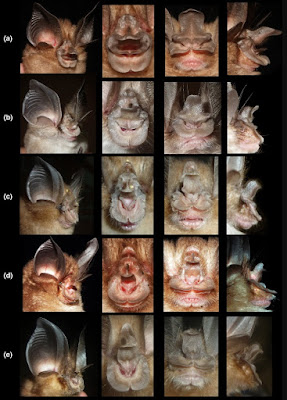Abstract
The taxonomic status of Rhinolophus macrotis sensu lato (s.l.) in Vietnam and adjacent territories remains problematic. To address this issue, we performed an integrated study of morphological, acoustic, and genetic characters of R. macrotis s.l. specimens and compared these with sympatric species within the philippinensis group (R. marshalli, R. paradoxolophus, and R. rex). Our results reveal that in addition to a cryptic species of R. macrotis previously found in Jiangxi and Jingmen, China, R. macrotis s.l. in continental Asia includes three further species, namely R. cf. siamensis, R. cf. macrotis, and R. cf. macrotis “Phia Oac.” These four taxa are distinguished from genuine R. macrotis in Nepal and R. siamensis in Thailand by their morphological and/or genetic features. Further taxonomic evaluation of the subspecies of R. macrotis s.l. is needed to determine their affinities with recently recognized cryptic species and to possibly describe new taxa. Our results also show that interspecific divergences in mitochondrial DNA sequences (Cytb and COI genes) among taxa within the philippinensis group (particularly between R. cf. siamensis/R. cf. macrotis and R. rex/R. paradoxolophus) are significantly lower than those of other morphological groups in the genus. These phylogenetic patterns might be explained by recent allopatric speciation or ancient introgression events among ancestors of the taxa during the Pleistocene. However, further investigations including genetic analyses of nuclear genes are needed to test the latter hypothesis.
Vuong Tan Tu, Alexandre Hassanin, Tamás Görföl, Satoru Arai, Dai Fukui, Hoang Trung Thanh, Nguyen Truong Son, Neil M. Furey and Gábor Csorba. 2017. Integrative Taxonomy of the Rhinolophus macrotis Complex (Chiroptera, Rhinolophidae) in Vietnam and Nearby Regions. Journal of Zoological Systematics and Evolutionary Research. DOI: 10.1111/jzs.12169
Morphological, acoustic, and genetic analyses on Rhinolophus macrotis complex and other taxa of the philippinensis group in Vietnam and nearby countries were conducted. Results show that the complex includes several distinct species which are distinguishable from genuine R. macrotis and R. siamensis by morphological and/or genetic features. Interspecific divergences in mtDNA sequences among taxa in the philippinensis group are surprisingly low and can be explained by recent allopatric speciation or ancient introgression events during the Pleistocene.
